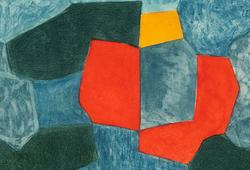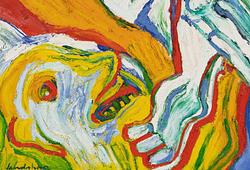Ilja Jefimovitj Repin, kopio
"Reply of the Zaporozhian Cossacks"
Oil on relined canvas 85 x 140 cm. Dimensions with frame 140 x 190 cm. Inscription on the reverse: "Painting by I. E. Repin, "Zaporoschie", copy painted by Osipov in Harbin, 1928".
Alkuperä - Provenienssi
Scandinavian collection since the 1960s.
Purchased by the current owner at auction in Denmark around the year 2000.
Muut tiedot
The current work is a copy after Ilja Repin's famous and beloved painting "Zaporozhian Cossacks Writing a Letter to the Turkish Sultan," executed between 1880 and 1891, which is currently in the collections of the State Russian Museum in St. Petersburg.
The painting bears an inscription verso stating that it was executed by the painter Osipov in the city of Harbin, northeastern China in 1928. In the 1920s Harbin was flooded with 100,000 to 200,000 'White émigrés' fleeing from the Russian Revolution, and the Russian Civil War.
The scene in the painting was prompted by a letter that, according to legend, was sent by Sultan Mehmet IV in 1675, demanding the immediate and unconditional submission of the Zaporozhians. The letter had no intended effect.
Repin worked on the painting for thirteen years, from the initial sketches in 1878 until 1891. The original painting, measuring 209 x 358 cm, is monumental. Repin was part of the artist group Peredvizhniki ("The Wanderers"), and the painting is an example of how the group approached historical themes.
The artists of The Wanderers, in opposition to the academy, ventured into the countryside to depict contemporary life and, above all the people, with an almost journalistic eye. Historical painting also received a reinterpretation, where history was viewed through the eyes of "the common man." The paintings are characterised by a high degree of realism, and Repin often worked with friends and acquaintances as models in historical depictions.
Repin's painting "Zaporozhian Cossacks Writing a Letter to the Turkish Sultan" was featured in the Swedish Nationalmuseum's major exhibition Peredvizhniki in 2011, and the catalogue recounts the following:
“---Repin first heard of this letter in 1878 and was fascinated by this fearless, lively, and untamed people, making the first sketches for the painting, which he worked on for thirteen years. He studied the history and life of the Cossacks and their self-governing organisation, the Zaporozhian Sich, in great detail. With great mastery, he brought the figures to life, creating expressive and deeply psychological portraits of the Cossacks and their leader, hetman Ivan Serko, highlighting their love of freedom, boldness, and camaraderie.
Repin based the character gallery on portrait studies of real individuals. Ivan Serko thus borrowed his features from artillery general of the Russo-Turkish War, Mikhail Dragomirov; the scribe is the Ukrainian historian Dmitry Yavornitsky, who researched the history of the Cossacks. The moustachioed man at the table, who is thumping his friend on the back, is the painter colleague Jan Tsionglinsky; the burly Cossack in the red caftan and white fur hat was named Alexander Rubets, a professor, Ukrainian musicologist, and folklorist.”
Dick Harrison wrote in the Historiebloggen of the daily paper Svenska Dagbladet on 24 October 2011 about the exhibition and especially about Repin's painting. “Generations of people of the most diverse ideological shades have loved it, from Tsar Alexander III (who bought it for a record sum) to the communists. In the 1890s, it won gold medals in both Germany and Hungary.”
Harrison further writes: “The painting depicts a group of laughing Zaporozhian Cossacks led by their leader, ataman Ivan Serko, writing a letter to Sultan Mehmet IV of the Ottoman Empire in 1676. The background is the sultan's demand for submission, which the Cossacks are said to have met with one of the most scornful letters in the history of diplomacy. The warriors are, in the painting's present, right in the midst of formulating some of the most cutting lines.”
(Bukowskis thanks the Oriental Carpet Society Pazyryk for this text.)





































































